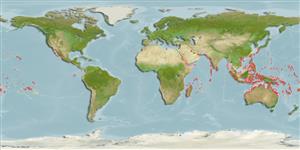Common names from other countries
>
Gobiiformes (Gobies) >
Gobiidae (Gobies) > Gobiinae
Etymology: Bathygobius: Greek, bathys = deep + Latin, gobius = gudgeon (Ref. 45335).
More on author: Bleeker.
Environment: milieu / climate zone / depth range / distribution range
นิเวศวิทยา
เกี่ยวกับทะเล,น้ำเค็ม; กร่อย เกี่ยวกับหินโสโครก; ระดับความลึก 0 - 10 m (Ref. 48637), usually 0 - 2 m (Ref. 89972). Tropical; 32°N - 28°S
Indo-Pacific: East Africa to Johnston, Marquesas and Tuamoto islands, north to southern Japan, south to the southern Great Barrier Reef and Rapa Islands; Marianas and Marshall Islands in Micronesia. Misidentified as Bathygobius fuscus in Hawaii (Ref. 7490).
ขนาด / น้ำหนัก / Age
Maturity: Lm ? range ? - ? cm
Max length : 12.0 cm TL เพศผู้/กระเทย; (Ref. 11344)
Short description
เครื่องมือที่ใช้ในการแยกชนิดสัตว์,สิ่งมีชีวิตออกจากกัน | สัณฐานวิทยา | ความยาวต่างๆ
เงี่ยงครีบหลัง (รวม) : 7; ก้านครีบอ่อนที่หาง (รวม) : 9; เงี่ยงครีบก้น: 1; ก้านครีบอ่อนที่ก้น: 8. Characterized by mottled brown overall color, with five alternating irregular whitish and brown blotches or saddles dorsally on body; lower half of side with 5-7 rectangular brown blotches; white spots and blotches on cheek and operculum; upper 4-5 pectoral rays branched to base, tips membrane-free; rounded caudal fin; longitudinal scale series 37-38; predorsal scales 10-12, nearly reaching to above rear margin of preopercle; scales absent on cheek and operculum; ctenoid body scales, becoming cycloid on abdomen, breast and nape; depressed head, width greater than depth; depth of body 5.0 in SL (Ref. 90102).
Lives among rubble, in sand pockets, or on reef rock and is abundant on silty intertidal reef flats (Ref. 9360, 58302). Benthic (Ref. 58302). Gut analysis composed of polychaetes, isopods, amphipods, and brachyurans (Ref. 9360, 48637).
Life cycle and mating behavior
Maturities | การสืบพันธุ์ | Spawnings | Egg(s) | Fecundities | ตัวอ่อน
Myers, R.F., 1991. Micronesian reef fishes. Second Ed. Coral Graphics, Barrigada, Guam. 298 p. (Ref. 1602)
IUCN Red List Status (Ref. 130435)
CITES (Ref. 128078)
Not Evaluated
Threat to humans
Harmless
Human uses
การประมง: การค้า; สถานที่แสดงสัตว์และพืชน้ำ: การค้า
เครื่องมือ
Special reports
Download XML
แหล่งที่มาจากอินเตอร์เน็ต
Estimates based on models
Preferred temperature (Ref.
115969): 24.7 - 29.3, mean 28.2 (based on 2826 cells).
Phylogenetic diversity index (Ref.
82804): PD
50 = 0.5000 [Uniqueness, from 0.5 = low to 2.0 = high].
Bayesian length-weight: a=0.00708 (0.00333 - 0.01504), b=3.09 (2.92 - 3.26), in cm Total Length, based on LWR estimates for this (Sub)family-body shape (Ref.
93245).
ระดับชั้นอาหาร (Ref.
69278): 3.5 ±0.6 se; based on size and trophs of closest relatives
ความสามารถในการกลับคืนสู่ปกติ (Ref.
120179): ความสูง, เวลาต่ำสุดที่จะทำให้ประชากรเพิ่มขึ้นเป็น 2 เท่าใช้เวลาน้อยกว่า 15 เดือน (Preliminary K or Fecundity.).
Fishing Vulnerability (Ref.
59153): Low vulnerability (10 of 100).
